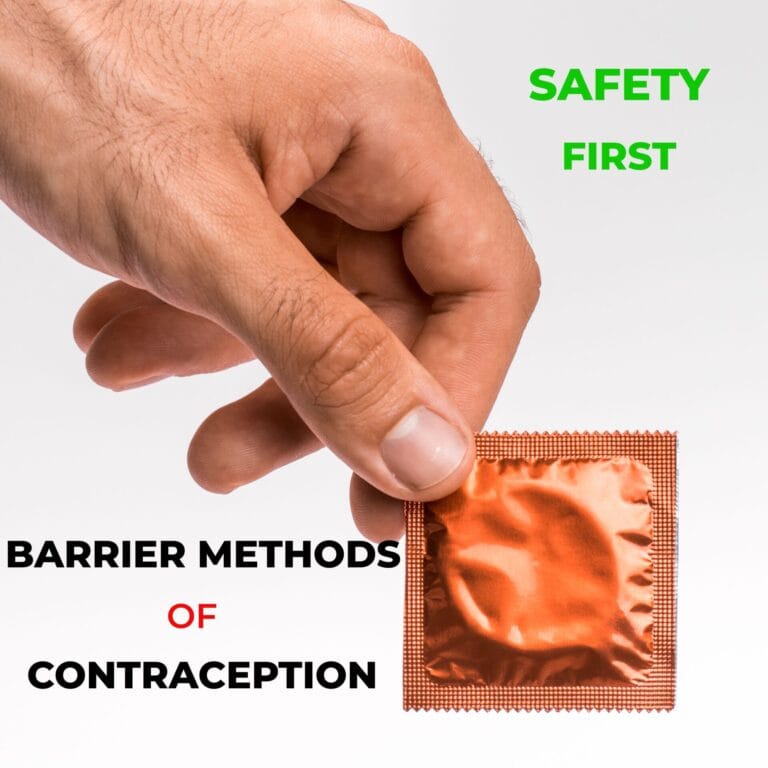What is barrier contraception?
Barrier contraception refers to the birth control methods that physically prevent the sperm from entering the uterus and fertilizing the egg.
Used correctly, barrier methods are extremely effective in providing contraception and also reduce the risk of transmission of Sexually transmitted infections (STIs) during any form of sexual contact. Thus they offer a Contraceptive Plus protection – contraception and prevention of STIs. The only exception is the diaphragm, which does not offer protection from STIs.
What are the different types of barrier methods?
There are many types of barrier methods available:
- Male condoms (External condoms)
- Female condoms (Internal condoms)
- Diaphragms
- Cervical caps
- Contraceptive sponge
- Spermicide
Male or External condom
The male condom is a thin, balloon-like pouch that is worn over an erect penis before sexual intercourse. The semen from the male gets collected in this pouch after sexual intercourse. So it prevents the semen from entering the vagina, thereby preventing fertilization of the egg.
It is usually made of latex or polyurethane but for people with latex allergy, it is also available as latex-free condom. It is also called external condom as it is worn externally before intercourse.
Male condoms offer many advantages over other birth control methods:
- If used correctly, they are very effective (about 98% efficacy) in preventing pregnancy.
- They also protect against transmission of sexually transmitted infections (STIs).
- The condoms offer increased efficacy if combined with other methods of contraception like oral contraceptive pills or intrauterine device (IUD).
- They are also some of the cheapest methods of contraception.
- They are easily available over the counter and there is no need to visit a doctor or get a prescription.
- If you change your mind and want to plan pregnancy, there is no wait period as it does not need any time for reversal of its effects. Just stop using it.
However, there are a few cautions that must be exercised for its use:
- First of all, you have to keep it handy and also remember to wear it each time before sexual intercourse.
- Condoms are strictly meant for single use only; you must discard them after use and use a fresh one each time.
- You have to be very careful while wearing it. It’s very thin and flimsy, so it can easily tear if care is not taken while putting it on. After wearing it, you should always check for any tears or air at its tip. If there is any air, remove the air.
- Despite taking every precaution, condoms can accidentally tear or slip off during intercourse and may fail to provide contraception. If this happens, you should immediately consult your doctor for advice regarding emergency contraception. Emergency contraception should be taken as soon as possible after contraceptive failure.
- Usually, lubrication is not needed as condoms are already lubricated. However, if you wish to use a lubricant, you should use a water-based lubricant as petroleum or oil-based lubricants can damage the condom.
- If you have a known allergy to latex, you can use polyurethane or polyisoprene condoms.
- If you did not have any known allergy to latex earlier but have developed allergic symptoms for the first time after using a latex condom, contact your doctor for advice regarding the treatment of allergy and further prevention. Treatment options will depend on the severity of the allergy. Usually, the allergy manifests as redness, rash or itching in the affected areas and a local ointment usually suffices for abating the symptoms.
Female or Internal condom
It is the female counterpart of male condom.
Just like the male condom, the female condom is also a thin, balloon-like pouch that is worn inside the vagina before sexual intercourse. The semen from the male gets collected in this pouch after sexual intercourse. So it prevents the semen from entering the vagina, thereby preventing the fertilization of the egg. It is also made of a thin rubber called nitrile and has a flexible ring at both ends. It is also pre-lubricated, so does not need additional lubrication. It is called internal condom as it has to be worn inside the vagina by the female before intercourse.
It shares all the advantages and cautions with the male condom, including high efficacy and prevention of STIs. Following are the additional advantages offered by female condoms:
- Being latex-free, they do not cause latex allergy.
- They are stronger and less likely to tear during intercourse.
- It can be used with both water-based or oil-based lubricants as its material is stronger and resistant to damage by oil-based lubricants.
- It can be worn two or three hours before the intended time of intercourse, and not just before intercourse, unlike male condoms. Also, there is no requirement for erect penis to wear it.
- Another advantage is that you do not need to remove it immediately after sex. It can removed even after a few hours, but you should remove it before standing up to avoid spilling of semen inside the vagina.
However, it has certain disadvantages as compared to the male condom:
- It is more expensive
- Less easily available
- Needs some practice to learn to put it on properly.
- Its efficacy is also slightly lesser than male condoms (95% vs 98%), presuming it is used perfectly. However, its efficacy in practice is much less as many women are not able to wear it properly.
Diaphragm
The diaphragm is also a barrier method of contraception. However, it does not offer protection against the transmission of STIs.
It is a soft, flexible, and shallow dome like device that is inserted into the vagina in such a way that it covers the cervix and does not let the sperms enter the uterus, thus preventing fertilization of the egg. Spermicidal jelly is a must for the use of the diaphragm. Spermicidal jelly placed in the dome increases its efficacy by killing the sperms. It is usually made of latex, rubber or silicone and is reusable. However, it is not recommended to reuse it beyond two years.
Advantages of using diaphragm:
- Reusable and can be used for up to 2 years.
- Since it needs to be inserted 1-2 hours before sexual intercourse, it does not depend on the last minute and lessens the chances of forgetting the use of contraception.
- Nowadays, newer diaphragms are one size for all and have reduced the need to go to a doctor to have them fitted properly.
- Does not affect breastfeeding and can be easily used during breastfeeding.
It has many disadvantages, making it a less popular choice:
- It has lesser efficacy than other barrier methods (about 85% vs 95-98% for condoms).
- It does not protect against sexually transmitted infections (STIs).
- It needs a lot of time management: It has to be inserted a few hours before intercourse, then has to be left in place for at least six hours after intercourse, but also has to be removed within 24 hours of intercourse. This makes it very cumbersome to use.
- It needs the use of a spermicidal jelly or cream for increasing its efficacy. Even after adding a spermicidal jelly, its efficacy is much lesser than condoms.
- Size is a major issue as it does not fit everyone properly. Ill-fitting diaphragms have a further reduced efficacy and you may also need visit a doctor to get a proper fit.
- You will need to get a new diaphragm after 1-2 years. You may also need a new diaphragm after you lose or gain weight, after your delivery, or after any pelvic surgery, as the fit of the diaphragm changes in all these conditions reducing its efficacy.
- If you want to use the diaphragm as a method of contraception after your delivery, you must wait for at least 6 weeks, to allow the uterus and cervix to return to their normal sizes.
- The spermicidal jelly may cause allergy, itching or irritation in some women.
- As mentioned before, the diaphragm must be left for 6 hours after intercourse, but can not be kept for more than 24 hours. It has to be removed within 24 hours due to the risk of developing a rare but serious condition called toxic shock syndrome (TSS).
So whenever barrier methods are considered, male or female condoms are generally used.
Cervical Cap
Cervical cap is another barrier contraceptive device, which looks just like a diaphragm but is smaller and shares the same advantages and disadvantages as the diaphragm. It is usually made of latex or silicone.
When inserted in the vagina, it covers the cervix and prevents the entry of sperms into the uterus. It should always be used with a spermicidal jelly.
Like the diaphragm, it needs to be inserted in the vagina a few hours before intercourse, then kept for at least 6-8 hours after intercourse and removed within 48 hours of intercourse. It is less efficacious, is difficult to use, not easily available, does not protect against STIs and requires the supervision of a doctor for the correct size and fit.
It is a less preferred barrier method as compared to condoms and diaphragm.
Contraceptive Sponge
It is a small, polyurethane sponge, containing a spermicide. Like other barrier methods, it does not let the sperms enter the uterus and fertilize the egg. The spermicidal jelly in the sponge kills the sperms.
It can be inserted in the vagina up to 24 hours before intercourse. It has to be left inside for at least six hours after intercourse and has to be removed within 30 hours of insertion. Keeping it more than 30 hours can lead to toxic shock syndrome, just as in diaphragm.
To use it, you first have to wet the sponge with water and then insert it in the vagina. Once wet, it starts releasing the spermicide.
Disadvantages: Less efficacy, less availability, no protection from STIs, chances of getting vaginal infections, chances of allergy from latex.
Again, it is a less preferred method of barrier contraception, as compared to better methods like condoms.
Spermicide
Spermicides are chemicals that damage the sperm and impair their ability to travel and fertilize the egg. They are available as many preparations like gels, creams, suppositories, and foams and are available over the counter at most places.
It is inserted deep inside the vagina, about 10-15 minutes before intercourse. Do not place it too early as it acts only for about 60 minutes after its placement. After 60 minutes, you will need to reapply again, if you need further contraception. Keep not wash away the immediately after intercourse.
It is less effective than other methods and is usually used in combination with condoms, diaphragm, contraceptive sponge, or cervical cap.
Disadvantages include less efficacy, no protection from STIs, increased incidence of vaginal infections, chemical irritation in the vagina and dependence on other methods for its use.
Bottomline
Barrier methods provide contraception by preventing sperms from fertilizing the egg. Condoms are the most easily available, least expensive, easiest to use, and offer dual advantages of pregnancy prevention and protection from STIs.
Each form of barrier contraception has its own merits and demerits. The choice of a particular method will depend upon you and your partner’s personal choices and the ease of use for you.
Stay safe, stay healthy, and practice safe sex!

For more such interesting information on women's health, kindly visit our website Expert Gynae Care and our YouTube channel @drnidhigarg
To consult Dr. Nidhi Garg, please visit us at Kamal Hospital, Doaba Chowk, Jalandhar-144004 or Visit our website kamal Hospital jalandhar or Expert Gynae Care



4 thoughts on “Barrier contraception: The Contraceptive Plus Protection”
Comments are closed.